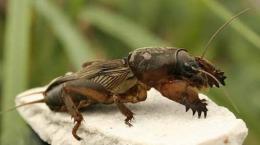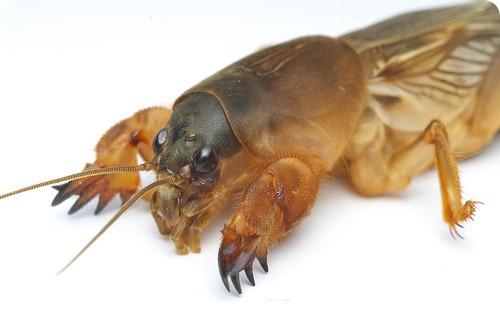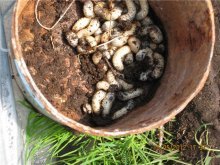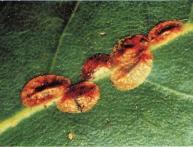How to deal with mole crickets in the garden: some tips

Spring is the time when the most active work in garden plots begins. Gardeners have to make beds, harvest and plant seedlings, but also fight pests, of which, unfortunately, there are a lot. One of the most common scourges, and the most difficult to combat, is the mole cricket.
Content:
Medvedka. A little about the pest
Before moving on to methods of combating this insect, it is necessary to become better acquainted with it.
So, the mole cricket is an insect that can feed on both plants and small insects, which is why it is so difficult to remove. It seems like she has nothing to eat, but she still doesn’t disappear.
Typically, this insect is no more than 3 or 4 centimeters in length, but in some cases it can grow up to 6 centimeters. It all depends on how well she eats. If we talk about its appearance, then if you take a closer look at it, it has very strong jaws, a dark body color, and claws. From the outside, it is no different from any other harmless insect. But if you don’t take any action and just watch the mole cricket, it will ruin all the plantings.
This the insect is able to move both in the ground, digging a passage for itself, and flying through the air, which makes it even more dangerous. And the most important thing is that she can even swim in the water, and does it very quickly.
The favorite place of existence is well-fertilized and moist soil, which, of course, is fully consistent with a normal vegetable garden in any country house. It is easy to understand whether there are mole crickets in the soil. Small mounds appear on it, which indicate the presence of an insect in the garden.
Separately, it is worth mentioning the breeding period, since it is the most dangerous. Around May or early June, when the most active work on the part of gardeners occurs, this insect begins to reproduce. One individual lays many eggs, which after a few weeks become active, turn into small individuals and leave the nest, spreading very quickly throughout the entire garden.
Due to the fact that it multiplies very quickly, it is necessary to use all possible methods to combat it, otherwise it will simply eat all the plantings and cause enormous damage.
Mole cricket habits

In order to better fight the pest, you need to know all its habits. Despite the fact that this is an insect, it has its favorite places and you can easily predict what the mole cricket will do after some time.
So, the most important thing is spot the insect in time. Experienced gardeners do this without much difficulty. For those who are just starting to garden, you need to know that mole cricket tracks are best visible after rain, when the places where it has found shelter become clearly visible.
Many people think that she only eats certain plants. But this is a misconception; she can eat absolutely anything. So, most often potatoes, cucumbers, tomatoes and much more are exposed to it. She especially loves those plantings that are planted as seeds, that is, carrots, lettuce, radishes, etc.
The mole cricket mainly damages the root system, since its strong jaws are excellent at chewing even large plants, or rather their rhizomes. Sometimes, while digging up the soil, a person may notice an insect, but after a second it disappears from sight. In fact, the mole cricket freezes and quietly watches the gardener, waiting for the right moment to run away.
If we talk about the time of year when it increases insect activity, then it is spring, namely May, when the air temperature becomes higher every day and the soil warms up more. When the soil temperature reaches about 15 degrees, then this is just the time for the mole cricket to “emerge”. It is during this period that individuals mate. It should be noted that one female is capable of laying about 400 larvae, which will later turn into full-fledged individuals and spread throughout the garden, devouring more and more plants.
It is worth mentioning separately that mole crickets overwinter at a depth of a meter in the ground or manure. And because of these characteristics of the insect, gardeners have developed many effective methods that help fight the pest and ensure the safety of plantings.
Insect control. Several ways

Many gardeners come up with their own ways to combat mole crickets. But, of course, the most effective are those that use chemicals. The main methods of pest control include:
- The main part of the fight With a mole cricket, it comes down to the fact that you need to find all its nests. This, of course, is not so easy to do, but as mentioned above in the text, it is easy to notice its presence. Gradually digging up the ground, you can find all the nests.After the first nest has been found, it must be carefully dug up and placed in a bucket. Moreover, this must be done so discreetly that the female, if she suddenly happens to be there, does not crawl out. After all the steps have been completed, you need to take a specially purchased chemical, which is aimed at destroying the mole cricket, and put granules in each passage leading from the nest. The next day the female will be dead.
- The principle is the same, you need to find a nest. But now you can use soapy water for baiting. Scientists conducted research and found that the female will also die from the soap solution. This solution must be poured into all passages so that it reaches the nest itself and the larvae, and, of course, the female. True, she is not always there. And if it was not possible to kill the female, then after some time she will lay more eggs in the same place.
These are the two main methods that many gardeners use to get rid of this pest.
“Homemade” preparations
As mentioned above, many gardeners come up with their own special ways to deal with insects. That is why special attention should be paid, on the one hand, to non-standard methods of struggle, but at the same time quite effective:
- Water with sunflower oil. You need to take four liters of water and a tablespoon of oil. After the nest has been found, solution must be poured into it and into all passages. After some time, the insect will crawl out and die due to the fact that the oil closes the respiratory tract.
- You need to purchase any small fish that is sold on the market. Then, dig small holes about five centimeters deep, and place the fish in these holes.It is generally accepted that the smell of fish repels insects.
- Need to find several alder branches. They are stuck into the ground at a distance of one and a half meters from each other. The mole crickets do not like the smell of alder and therefore they leave the garden. However, you need to remember that after the branches have dried out, they need to be replaced with fresh ones.
- Sand with kerosene. Sometimes gardeners pour sand between the beds, which has previously been moistened with kerosene. Its smell repels the pest.
- Ammonia. Many people, when planting seedlings, water them with water and ammonia. You need to pour water right up to the roots so that the solution does not get on the leaves and harm the plant.
- Ideal for those who do not like to use chemicals in the garden. At the very beginning of spring, you need to scatter small piles of manure around the garden. They will attract mole crickets, and in each of these piles there will be a nest and eggs laid. Then you will need to collect all these piles and crush the eggs.
- Another plant, or rather a flower, that insects do not like is the chrysanthemum. Some people use the stems of branches to repel insects. You just need to bury a small piece of the stem when planting. It is this stalk that will ensure the integrity of the plant.
Dealing with a mole cricket is not easy, especially for a novice gardener, who may not immediately understand that a pest has infested his garden. That is why the easiest way would be to purchase a special poison that can remove mole crickets from the garden. True, you need to poison carefully so that not a single drop falls on a person.
Tips for fighting mole crickets in the video:
Interesting information about the vegetable garden











Comments
Thanks for the good advice, we'll try to use it. Otherwise, we are constantly looking for ways to combat this cabbage weed, so far we have only removed it with poison.
Guys, we’re fighting a mole cricket, catching it, luring it out, baiting it... but it turns out it’s not that bad, here on the website They even sell it, they write that it has healing properties for pulmonary diseases. Is this really true? Maybe we should start breeding it instead of fighting it :)))
For some, it may be useful, but it can turn any garden into ruins. I, for example, am committed to getting rid of this pest. For this I use an ordinary sititek repeller. And those who need a mole cricket for treatment can catch it at the boundary.
I, too, am determined only to get rid of this scourge. Where do you install your sititek: in the center or in the middle of the garden? Will one device be enough for 6 acres?